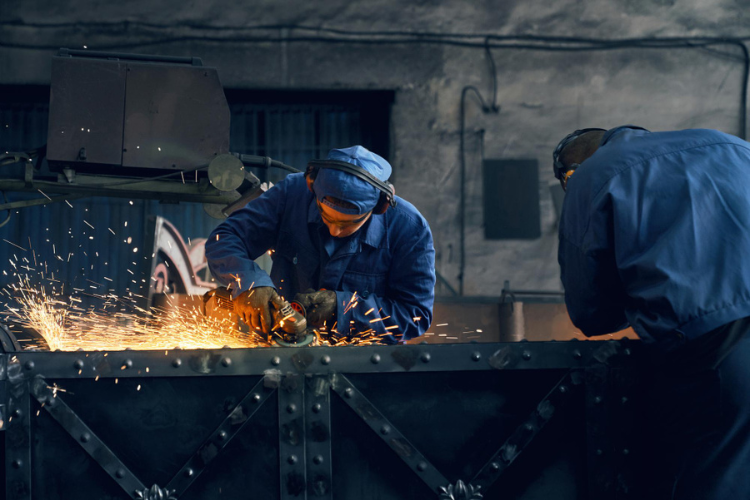Table Of Contents
- Understanding CFM And Its Importance
- Factors Influencing CFM Requirements
- Material Type
- Welding Process
- Workspace Size
- Calculating CFM For Welding
- Air Changes Per Hour
- Selecting The Right Ventilation System
- Portable Fume Extractors
- Centralized Ventilation Systems
- Ensuring System Effectiveness
- Additional Safety Measures
- Cost Considerations And ROI
- Get The Number Right
Tips on Calculating How Many CFM for Welding You Require
I’ve been around welding long enough to know one thing — clean air isn’t optional. You can have all the fancy gear in the world, but if your shop feels like all you are breathing is smoke, you’re doing it wrong.
Now, a big part of keeping that air safe comes down to something called CFM — cubic feet per minute. Understanding how many CFM for welding operations is essential for safety and efficiency.
Sounds technical, but once you get the hang of it, it’s not that bad. The right airflow keeps fumes out of your face, your lungs happy, and your welds clean. Miss the mark, and you’ll know it pretty quick.
Understanding CFM And Its Importance
Here’s the deal: CFM is basically how much air gets pushed through your ventilation every minute. Not enough, and fumes hang around like an unwanted guest.
Too much, and your fan works overtime for no real reason. You’ve gotta hit that sweet spot where the air moves steadily but doesn’t blow your shielding gas everywhere.
Think of it like this — it’s less about numbers and more about balance. You can tell when the air feels right; it’s one of those things you just notice after a while.
Factors Influencing CFM Requirements
So how much CFM do you actually need? Well, that depends on a few things: what you’re welding, how you’re welding, and where you’re doing it. No magic number fits everyone. It’s like asking how loud the radio should be — depends on the song, right?
Material Type
Different metals make different fumes. Stainless steel? That stuff kicks out hexavalent chromium, which is no joke — you want serious ventilation for that.
Mild steel’s a bit easier on the lungs, but it still needs some airflow. The point is, know what you’re burning through before you start guessing numbers.
Welding Process
Then there’s the process itself. MIG, TIG, stick — they all throw off fumes in their own way. MIG’s the smoky one. TIG’s cleaner but not harmless. Stick sits somewhere in the middle. You figure out what you’re running most days, and that’ll tell you what kind of air setup makes sense.
Workspace Size
And of course, the shop itself. Big space? You’ll need more airflow to push fumes out evenly. Small garage setup? Less CFM, but better focus — you don’t want the fumes trapped right around your face.
If you’ve ever worked in a tiny, closed room, you know what I mean. It gets thick fast. OSHA, or Occupational Safety and Health Administration, even says larger spaces need wider air movement — makes sense when you think about it.
Calculating CFM For Welding
Here’s the easy version: measure your space — length, width, height — and multiply that out. That gives you the total air volume. Then decide how many times you want that air changed per hour. More changes mean cleaner air.
It’s not rocket science; it’s just basic math. But it’s worth doing, especially if you’ve got a few folks welding at once.
Air Changes Per Hour
Every space needs air swaps to stay safe. Most shops do fine with four to twelve changes an hour, depending on what you’re welding. If you’re burning through stainless or other stuff that gives off heavy fumes, aim high. You’ll breathe easier, and trust me, your head won’t pound halfway through the day.
Selecting The Right Ventilation System
Once you know your numbers, the next move is picking your setup. You’ve got a few choices — portable fume extractors, local exhaust systems, or full-blown central ventilation. Each has its place. Don’t overcomplicate it; think about your shop size and how often you weld.
Portable Fume Extractors
If you’re hopping between jobs or working in tight corners, portable extractors are gold. You roll them over, point the nozzle near your work, and they do the job. I’ve used a few — great for quick stuff. But yeah, they can’t handle big open shop floors. They’re more of a “spot solution.”
Centralized Ventilation Systems
Bigger shop? Go with a centralized system. Costs a bit, but you only cry once. They pull air evenly across the room and handle higher CFM for welding like a champ. It’s one of those upgrades you don’t regret later. Once it’s running, it just… works.
Ensuring System Effectiveness
After you’ve got everything set up, don’t just forget it exists. Filters clog, fans slow down, ducts get dusty. Give it a quick check every so often.
Clean filters mean your system’s not fighting itself. I make it part of the regular shop routine — like checking gas levels or replacing wire. A five-minute look now saves you hours of cleanup later.
Additional Safety Measures
Even with good ventilation, I still wear a respirator when things get heavy. Doesn’t hurt to double up. The fumes from certain metals can sneak up on you. And honestly, if you’ve got a crew, keep safety talks regular. Nobody likes them, but everyone remembers them when something goes wrong.
Cost Considerations And ROI
Now, yeah — all this costs money. But you know what costs more? Sick days. Lawsuits. Replacing guys who quit because the air feels like a fog machine. A decent ventilation system is an investment, not an expense. Cleaner air means better focus and fewer problems.
If you look at the long game, it pays for itself. Always does.
Get The Number Right
Getting your CFM for welding right isn’t about fancy numbers — it’s about safety, comfort, and doing your best work. Think about your metal, your method, and your space. Do the math once, set up your system, and keep it maintained.
When the air’s clean, the welds come out better, and you don’t go home feeling like you’ve swallowed a smoke cloud. I learned that the hard way once — never again.















